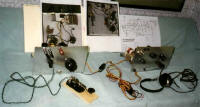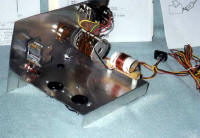
AB-64 Sets Set-Up Out Of Case |
AB-64 North
Vietnamese Agent Radio
In 1994 the Central Intelligence Agency declassified many documents to
include an article in an in-house magazine titled Adversary Agent Radios
that was written by James J. Fauth and published in Vol. 10 the Winter Issue
1966. Despite several errors, the article had some good information. There
were three considerations for agent radios, beyond the basic one of signal
strength (and consequent circuit reliability) which were paramount in the
design of agent radios, Security, portability, and simplicity of operation.
Simplicity of operation was the inverse of the requirements for operator
skill and training. The more sophisticated the equipment, the less training
was required. |
The article discussed Bulgarian, Polish, Soviet, East German and the Asian
bloc which included China, Korea and North Vietnam. The Asian bloc radios were
less impressive and less disparate than in Europe. All used older techniques as
Soviet knowledge of high speed automatic keying systems was not shared with the
Asians. The most advanced radio shown was a Chinese set supposedly made in 1963.
A North Korean set was shown which was hand made and came complete in a large
storage chest.

AB-64_Transmitter |
The North
Vietnamese set that was shown was listed as being of 1963 vintage but I
question the accuracy of the CIA's dates. The set was probably captured in
1963. Looking at a 4th generation photocopy does not provide much detail but
the set appeared to be two sets, probably a receiver and a transmitter. The
parts were mounted on a front panel or a chassis panel which was attached to
the front panel. The "chassis" had no side panels for strength. Guessing at
the size, based on the components the sets were probably 12 inches wide and
6 inches high. The "chassis" portion was probably about 4 inches deep. Both
sets were mounted in a metal chest, much like some of the WW II Japanese
sets. The one set that was removed from the case looked much like the
Japanese TM Handy Wireless set which slid in and out of a case. While the
Japanese set was a Bakelite panel attached to a wooden base, this set was
made of metal. |

AB-64 Receiver Chassis |
The caption under the picture read: "A simple two tube transmitter and
regenerative receiver believed to be used by the Viet Cong. The system is
contained in a crude square container; it apparently operates on dry cell
batteries." The CIA article said that operating from jungle base camps,
constantly on the move and communicating over ranges of 100 to 200 miles the set
was adequate. I tend to question that this was an "Agent Radio" in the true
sense but more likely just another of their home brew sets used for all forms of
communication.

AB-64 Receiver Underside |
Further research
showed the same radio in the 1967 Technical Intelligence Bulletin, published
by the Combined Material Exploitation Centre in Vietnam. It was designated
the AB 64 set. Where this designation came from is unknown. It was supposed
to have a range of 20 miles and used 1.5 volt filament tubes and B+ voltages
of 90 and 150. I decided that this was
another candidate for a reproduction set. My concession to practicality was
to use 6 volt filament tubes. I had a local metal shop produce a case for
the two sets and then made two chassis which could be placed in the outer
case. Since the original set is long gone to somewhere, I did not have any
schematics nor a clear picture of the controls.
The transmitter was the simple 6L6 circuit common among home brew
transmitters of the 1940s and 1950s. I did however use a 6V6 tube which has
the same pin configuration and was also used in the Para set of WW II. I
have been told that the Para set used the 6V6 tube as it was common in
broadcast radios of the 1930s and 40s and could easily be found by "robbing"
a broadcast set. |

AB-64 Reproduction Set |

AB-64 T.I.B. |
The receiver was
much more of a challenge. It had the power cables and other controls.
Looking at the pictures, it seemed to have more dials and switches that was
needed. I used a DPDT toggle switch to divert B+ from transmitter to
receiver. One pole handled 90 volts and the other pole handled the150 volts
for the transmitter. Since both transmitter and receiver had additional
toggle switches, I used them for controlling filament supply. I also had
constructed a small receiver based on a 6LN8 tube which covered 2 -12 Mhz.
It used a switch to change the freq range. For this switch I used a SPST
slide switch and there were two on the front panel. A standard 365mmfd
capacitor was the main tuning capacitor. I located a four position rotary
switch which I decided would work for a band switch. The plan was to used
different coils mounted to the chassis and then switch between the coils.
The first coil was wound and mounted and the set was tested. It was dead as
a door nail. Several attempts were made to get it working and I finally
located Pete McCollum who agreed to try to get it working. I shipped the set
out to him and he went to work. After a few changes to the circuit, he
managed to get it going. |

AB-64 Receiver Circuit Diagram |
Back to Communication Equipment of The North
Vietnamese Army and the Viet Cong.
Army Radio Sales Co. Home Page.







